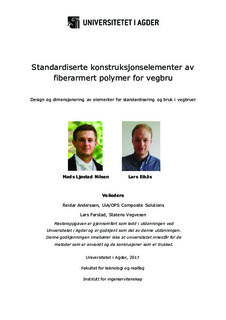| dc.description.abstract | This thesis is addressing the possibility for use of fiber reinforced polymers (FRP) in bridge constructions in Norway. The aim is to design an FRP section that can perform as both structural support and decking on the bridge, in a similar way as often is done with concrete. The advances of using FRP composites is that it is possible to make the bridge sections a lot lighter, and consequently possible to fabricate them in remote locations and transport them to the construction site. This will make the time necessary for construction on site a lot shorter in cases where old bridges need replacement.
To make FRP-composite bridges economically feasible it is necessary to make a section that can be reproduced many times over, as much of the cost of a composite section is in the making of formwork. Making a standardized section will hopefully also bring down the time and cost of engineering the bridge. In this thesis, the focus is on a standardized section that can be used on bridges up to 10 meters in span. In Norway, there are 18 199 bridges, and approximately 10 000 of these are under 10 meters, which means that there is a lot to be gained from standardizing with these constraints.
In FRP composites, low elasticity modulus (Young’s modulus) [1] gives problems with deflection long before the loads are high enough to give problems with strength. This is opposite of what is the case with materials as concrete and steel were strength of the material often becomes a problem before the maximum deflection. In a stiffness based design of a bridge, the deflection requirement is given by The Norwegian Public Roads Administration (NPRA), who is the governing authority on the construction and building of bridges in Norway. Through their manuals, they give requirements for how a bridge shall behave under different circumstances. The N400 manual[2] is the most specific for bridge construction, and specifies that a bridge should maximum deflect L/350. In the case of a 10-meter bridge that gives a deflection of maximum 28,6 millimeters.
Using finite element analysis and application of theory as well as material data from laboratory testing, this thesis will try to fulfill this requirement.
The conclusion of this thesis is that it is possible to produce a standardized composite element consisting of several identical items glued together for use as bridge decking together with edge beams. This bridge construction is very light weight, in fact so light that adding asphalt will triple its weight. It is a wish from the NPRA to make standardized alternatives in different materials to see which is the most efficient in terms of execution time and price.
FRP composites is a lighter alternative so that transport from fabrication and storage, out to the mounting site is a lot easier to execute than for heavier material as concrete and steel. It is also easier to maintain, as there is no steel beams, reinforcing steel or steel bearings in the bridge that can corrode. | nb_NO |

